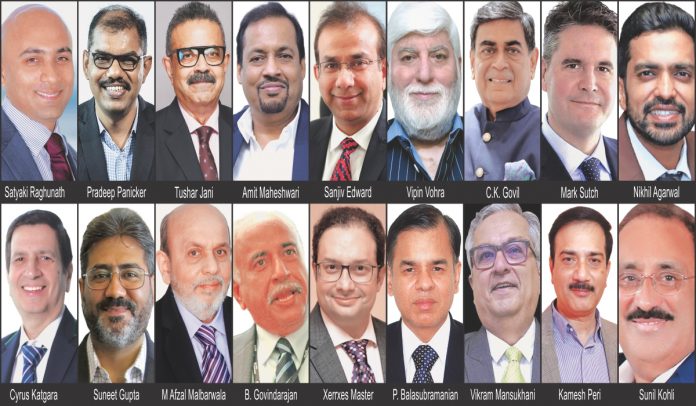Upgrading global and regional airports and building new airports with dedicated cargo terminals will augment cargo volumes and transportation. Distribution between belly and freighter has been stabilized at 70% and 30% between air cargo in belly hold and freighter, respectively. Cargo hubs such as Delhi, Mumbai, Bengaluru, Chennai, and Hyderabad have been instrumental in trade facilitation.
Ritika Arora Bhola
According to a latest report by Research and Markets,’ India’s air freight market is estimated to be US$13.08 billion in 2023 and is expected to reach US$17.22 billion by 2028, growing at a CAGR of 5.65 per cent. This ambitious target, a testament to India’s economic aspirations, is underpinned by a multifaceted approach. Ranked 12th globally, the country handles around 5.3 MMT of cargo annually, recording a growth of 7 per cent over the past five years.
Domestic cargo contributed roughly 40 per cent of the total throughput, while global cargo added up to the remaining 60 per cent in FY 2023. The distribution between belly and freighter has now been stabilized at 70 per cent and 30 per cent between air cargo in belly hold and freighter, respectively. Key cargo hubs such as Delhi, Mumbai, Bengaluru, Chennai, and Hyderabad have been instrumental in trade facilitation, but the potential for increased volumes still needs to be tapped to achieve the government’s ambitious target of 10MMT by 2030.
Upgrading existing global and regional airports and building new airports with dedicated cargo terminals will augment cargo volumes and transportation. Enhancing road and rail linkage, developing MMLPs, advanced warehousing techniques, streamlining customs clearance processes, reducing paperwork, and adopting digital solutions will help. The key growth drivers will be e-commerce, globalization of supply chain, and increasing demand for air cargo services from various sectors, including pharma, manufacturing, agri, and electronics. The potential of perishable cargo has been a major contributor to this development.
“The airport infra in metro cities is adequate to handle 10 MMT and a different strategy should be used for both passenger and cargo. The passenger traffic should be allowed to reach tier II and III cities directly. However, cargo should come to main gateways to bring the efficiency of wide-body large capacity aircraft, which will bring down the cost and will be faster and seamless,” emphasized experts. Boosting cold chain capabilities, express networks, and regional connections is important too. PPP mode will be pivotal in enabling this four-fold growth within the decade. Policy reforms, incentives and skill development will complement the creation of efficient multimodal logistics ecosystems, the experts added.
“If we look at the current developments, to encourage exports, 40 air cargo terminals have been constructed, while 30 airports have been provided cold-storage facilities. This apart, 35 multimodal hubs are also in the pipeline. The government has worked towards initiatives such as paperless EXIM trade process through e-Sanchit, faceless assessment for customs, provisions for e-way bills, and FASTag.
Now, to move ahead, the air cargo industry needs to focus on e-commerce, both domestic and cross border, apart from the airlines enhancing their capacity and fleets catering to the assorted destinations.
Speaks to experts to find out their growth plans and strategies to achieve 10 MMT of cargo by 2030 and make the dream come true.
Enhancing efficiency to streamline processes
Satyaki Raghunath, Chief Operating Officer, Bangalore International Airport
Reflecting on the air cargo performance at BLR Airport in 2023, we processed 422,644 metric tonnes of cargo, which indicates a 2 per cent increase from the previous year. The airport continues to be the top hub in India for exporting perishables for the third consecutive year. In line with the government’s vision for increased cargo throughput by 2030, our strategic investments, including the addition of Menzies Aviation Bangalore Pvt. Ltd., and WFS Bangalore Pvt. Ltd., signify a pivotal moment in our cargo growth story. These partnerships bolster our capacity, efficiency, and overall growth trajectory. We are poised to achieve a cargo capacity of 1 million MT by the end of this decade. Embracing advanced technologies and innovation, BLR Cargo is aiming to set new standards as we are determined to streamline processes, enhance efficiency, and solidify our position as the preferred cargo gateway to South and Central India.”
Boom in cargo traffic in tier II and III cities
Pradeep Panicker, CEO, GMR Hyderabad International Airport
To achieve the ambitious target of 10 MMT by 2030, a multi-pronged approach is necessary.
- Airport modernization: Upgrading existing airports and building new ones with dedicated cargo terminals. Ongoing expansions in Delhi, Mumbai, Hyderabad, and Bengaluru are underway with plans for Greenfield cargo airports in Chennai.
- Logistic infra: Enhancing the road and rail connectivity, developing MMLPs, and implementing advanced warehousing.
- Customs simplifications: Streamline customs clearance process, reduce paperwork, and adopt digital solutions. Ongoing efforts include paperless trade initiatives and promotion of Authorized Economic Operator (AEO) certification.
- Global connectivity: Strengthen air cargo relations with key trade partners through bilateral agreements and route expansions to boost cargo volumes.
Additionally, we have witnessed a boom in air cargo traffic in tier II and III cities. The growth is attributed to the invcrease in manufacturing units, increased industrial output, and the expansion of e-commerce industry. The potential in perishable products has been a major contributor to this development.”
Govt-industry must unite to boost cargo
Tushar Jani, Group Chairman, Cargo Service Center
The airport infrastructure in metro cities is adequate to handle 10 MMT and we should use a different strategy for hub and speak for passenger and cargo. The passenger traffic should be allowed to reach remote locations directly. However, cargo should come to main gateways to bring the efficiency of wide-body aircraft, which will bring down the cost and uplift will be faster and seamless. This will help achieve freight tonnage targets. The challenges that we face at the gateway airport if we lose the tonnage traffic to tier II and III cities, then existing tonnage at the gateway traffic will have to bear a higher cost. This, in other words, may affect Indian imports and exports. It is time that the government along with the industry develops a comprehensive strategy and execution plan for cargo, which may or may not be different from the passenger.”
PPP mode pivotal in four-fold growth
Amit Maheshwari, Co-founder & CEO, Softlink Global
India’s air cargo sector is preparing to hit 10 MMT of annual throughput by 2030, driven by strategic expansions in infrastructure, technology and sustainability. Key moves include modernizing top airports, while boosting cold chain capabilities, express networks and regional connections. The Public Private Participation mode will be pivotal in enabling this four-fold growth within the decade. Policy reforms, incentives and skill development will complement the creation of multimodal logistics ecosystems. With air trade expected to outpace global averages, these efforts across stakeholders could unleash the sector’s potential. My suggestion is that we should leverage technology to launch an integrated nationwide e-Booking marketplace and control tower for air logistics. This digital platform can consolidate real-time capacity across airports, carriers, and handlers on to a common portal.”
Better linkage must from regional cities
Sanjiv Edward, CEO, Cargo, GMR Airports
Current air cargo traffic in India is approximately 3 MMT per annum, 30 per cent of the central government’s 10 MMT target, giving us ample head room to grow. Growth is actuated by India’s Gross Domestic Product, in 2030, poised at US$7.3 trillion from current levels of US$3.7 trillion. Given that national growth will be at twice the size, opportunity is complimentary to its speed and volume. Adding more international trade, adoption of updated digital, and physical infrastructure will be the significant strategy. Tier II and III airports needs better connectivity—transport and digital highway. However, non-compliance of regulations, maze of non-standard processes and ignorance to ESG can impede our trajectory and speed.”
Need more airports to ease congestion
Vipin Vohra, Chairman, Continental Carriers
India’s ambitious goal of achieving 10 MMT annual cargo throughput by 2030 necessitates strategic initiatives.
- The government focuses on expanding cargo handling beyond airports, establishing off-airport locations to alleviate congestion during peak periods
- Prioritizing tier II and III cities enhances accessibility and facilitates increased cargo movement. Key to success lies in the implementation of the NLP and the PMGS
- Additionally, addressing challenges related to cargo handling tariffs by supporting CTOs is vital for growth and competitiveness and reduction in the overall logistics cost. These steps will propel India to streamlined cargo ecosystem.”
AI-enabled systems in cargo ops must
C.K. Govil, CMD, Activair Airfreight India & President, ACAAI
India handled around 2.5 million tonnes of cargo worth US$13 billion last year, which is likely to increase up to US$17.22 billion by 2028. Two most critical things for achieving the ambitious target as high as 10 MMT by 2030—infrastructure and technology. The country has made rapid strides in aviation infrastructure in the past few years. Of the 21 new greenfield airports planned across the country, 12 have already been operationalised. We can see a strong focus on the emergence of Artificial Intelligence-enabled apps and systems to facilitate daily air cargo operations. Clearly, we are on the right path to make 10 million MMT a reality by 2030.”
Focus on cargo infra in tier II & III cities
Mark Sutch, CCO, CarGo, IndiGo
To maximize its freighter operations in 2024, IndiGo is tailoring its services to cater to the specific cargo needs, such as e-commerce, perishables, and time-sensitive items. The firm is focusing on enhancing the cargo terminal infrastructure in tier I and II cities, as well as evaluating the addition of more routes for China and Southeast Asia, creating air cargo-friendly routes, and ensuring efficient and seamless transportation. IndiGo leverages its advantage by strategically deploying freighters on high-demand routes complementing its extensive domestic network. It provides belly cargo space in its fleet of more than 300 aircraft along with three dedicated A321F freighters, which are key to achieving a target 10 million MT by 2030.”
Delivering tailored air cargo solutions
Nikhil Agarwal, President, CJ Darcl Logistics
CJ Darcl is actively contributing to India’s aspiration of becoming one of the leading air freight markets by 2025, thereby bolstering the nation’s economy. Distinguished by a unique market proposition, CJ Darcl serves as an authorized agent for major airlines, facilitating air cargo bookings nationwide. Additionally, the company holds accreditation from IATA, paving the way for global expansion. With a seasoned team possessing extensive airline expertise, CJ Darcl strategically positions itself for domestic market consolidation and imminent international growth. The company envisions delivering comprehensive and tailored solutions to meet customer requirements, aspiring to emerge as a prominent leader in the air cargo industry.”
Need to unlock India’s potential as international trade hub
Cyrus Katgara, Partner, Jeena & Company
India’s vision of achieving 10 MMT of annual cargo throughout by 2030 fills the industry with optimism. Though bold, everyone deeply resonates with this target given our nation’s growing economic ambitions.
The rise in greenfield airports in tier II and III cities, guiding trade beyond metros, rise in digital towers, streamlining processes, and crafting cargo AI to aid optimization are propelling us toward that goal. But there are challenges such as infra gaps, a skilled workforce, and perpetual navigation through global challenges that need to be addressed. This target is not just about numbers; it is about unlocking India’s potential as a global trade hub. Reaching 10 MMT of annual cargo will enable us to reach distant shores faster and deliver imported components with precision.”
Govt tackling logistics cost to boost exports
Suneet Gupta, Global Head, Cargo, Community Systems, Kale Logistics Solutions
The Union Ministry of Civil Aviation is committed to elevating the air cargo industry, targeting 10 million metric tonnes by the year 2030. Currently, the air cargo tonnage, standing at under 3.5 million MT, encompasses exports, imports, and domestic air cargo. Recognizing the significant role of air cargo, the central government is employing a multi-pronged strategy to tackle increased logistics cost, aiming to reduce them from 14 per cent to 9-10 per cent. This initiative not only boosts export potential but also makes air cargo more appealing for various commodities and fostering economic growth. Emphasizing on technology, there has been a concerted effort to enhance air cargo speed, efficiency, affordability and indicating a forward-looking approach to the advancement of the industry.”
Negotiating bilateral pacts to boost cargo
M Afzal Malbarwala, Managing Director, Galaxy Freight
Focusing on setting up new air routes, enhancing existing ones, and negotiating bilateral agreements with key trading partners, would boost the cargo movement, contribute to growth of aviation industry, and create more job opportunities. The key drivers are e-commerce, globalization of supply chain, and the increasing demand for air cargo services from various sectors, which include manufacturing, agriculture, pharmaceuticals, and electronics, among others.
Customs and regulatory reforms: To facilitate smoother cargo movement, the government is simplifying documentation, adopting digital platforms, and single-window clearance mechanisms, and implementing efficient clearance processes. Public Private Participation are being encouraged to drive investments in cargo infra, technology, and logistics solutions. Green initiatives—adoption of cleaner fuels, energy-efficient technologies, and waste reduction measures, are integral to India’s vision. By prioritizing sustainability, India aims to balance economic growth with environmental responsibility in its maritime activities.”
India moving towards industrial economy
B. Govindarajan, Chief Operating Officer, Tirwin Management Services
Considering the current level hovering over near four million with seven years ahead, I am optimistic to meeting the target of 10 MMT by 2030 is achievable something which was impossible in the past. Optimism gets strengthened since India is moving towards a manufacturing economy. Domestic air cargo is likely to stay in slow track not because there is no domestic cargo, but because of excellent road infrastructure created in recent days. The global air cargo growth depends upon:
- Exploring new products and new markets taking advantage of emerging geopolitical opportunities.
- Creating cargo processing infra, not just in gateway airports but in off-airport locations and tier II and III cities
- Liberating air cargo from dependency on foreign airlines. Building robust national air cargo capacity and ecosystem—core element for sustainable growth.”
Major players invest in tier II & III cities
Xerrxes Master, President, AMTOI
National Logistics Policy (NLP) will drive air cargo growth:
- Dedicated air cargo corridors: Setting up road and rail links between production and consumption centres to expedite cargo movement.
- MMLPs: Integrating air, land, and sea operations within these parks to enhance intermodal transportation.
- Infrastructure upgr-adation: Modernizing ports, railways, and airports to boost capacity and efficiency.
- Technology Integration: Implementing logistics management systems and automation for streamlined processes and reduced costs.
- Export Boost: Initiatives such as ‘Krishi Udaan’ for agricultural goods and ‘Make in India’ for manufactured products to drive export growth. Major players in airports, logistics, and shipping are actively investing, particularly in tier II and III cities. However, the challenges persist, including inefficient infrastructure, a shortage of skilled manpower, complex regulations, and the need for seamless multimodal integration. Addressing these challenges requires concerted efforts from the government, private sector, and industry stakeholders. Continuous focus on infrastructure, policy reforms, technology adoption, and skill development is crucial. “
Improving road network essential
P. Balasubramanian, Founder & CEO, Air Cargo Consultancy International Services
India will reach this target with contribution from several angles such as surging cross border e-commerce, continuous refinement of regulations and procedures, especially from customs. The latter raises optimism in getting customs regulations, while protecting the national interests.
These enablers are not sufficient by any stretch of imagination. Improved road network starting from Bharat Mala, the railway freight corridors, huge impetus for inland waterway shipping—all these factors would influence domestic and global cargo from feeding/distribution perspective. Transhipment of domestic, international and, intra domestic and international, are fully in compliance with security and customs needs is not utopia but a real possibility. It appears that there are hesitations and dragging of feet at some quarters which has prevented this from being implemented, should we look at our larger ambition to become US$5 trillion economy by 2028, pushing the country up to third place.”
Dedicated freighters to realise 2030 target
Vikram Mansukhani, National Operations Head, Blue Dart
In FY2022, our country’s airports efficiently managed 3.14 million metric tonnes of freight, propelled by robust developments in cargo infrastructure—dedicated freight corridors, cold storage facilities, transhipment hubs, Grade ‘A’ warehouses, and expanding regional cargo complexes. Driving this expansion are important sectors, such as e-commerce, fast moving consumer goodss, retail, chemicals, pharmaceuticals, automotive, and industrial goods. Achieving the 2030 target demands deploying dedicated freighters and expanding airports from 140 to 225 by FY25. Despite challenges such as tariff disparities, proposed reforms aim to spur privatization and infrastructure development. Initiatives such as ‘Fly-from-India’ and an integrated digital supply chain through the NACCS platform showcase the industry’s commitment to innovation.”
Road network linking airports necessary
Kamesh Peri, CEO, Celebi Delhi Cargo Terminal Management Pvt Ltd
This vision is a challenging yet significant. This will be a strategic measure towards transforming the country into a prominent international air cargo player. Achieving this vision requires meticulous assessment of cargo demand, capacity and infrastructure issues. Outside of traditional international and domestic traffic, focus on transhipment volumes should be a must.
Developing international cargo hubs would be another significant enabler. Tier II and III cities will have to emerge as crucial players, housing dedicated cargo terminals. Furthermore, developing a robust road feeder network to supplement air capacity gaps in certain regions need also to be considered.
This intricate air-ground expressway will seamlessly connect tier II and III cities with key cargo hubs. Admittedly challenges exist, policy inertia sometimes stifles progress, so that all the government bodies along with the trade need to come together as one unit, indicating a cargo movement, streamlined participation and decision-making.”
Industry needs to focus on e-commerce
Sunil Kohli, Managing Director, Rahat Cargo
The government is committed to improve export growth and connectivity. As many as 40 air cargo terminals have been constructed, while 30 airports are providing cold-storage facilities. While this was so, 35 multimodal hubs are in the pipeline. The government is working towards initiatives such as paperless EXIM trade process through e-Sanchit, faceless assessment for customs, provisions for e-way bills, and FASTag, among others, that have increased the efficiency of the logistics sector. Upgrading several airports in satellite towns have already been initiatedV to provide seamless connectivity from even remote locations. However, the challenges remain to overcome the shortage of skilled personnel to cope with the latest technological innovations. The industry needs to focus on the e-commerce factor in the coming years, apart from the airlines enhancing their capacity and fleets catering to the many destinations. The shippers need to equip themselves with digital technologies and the same applies to the freight forwarders too to achieve a faster, smooth and paperless chain of events from packing to delivery.”















